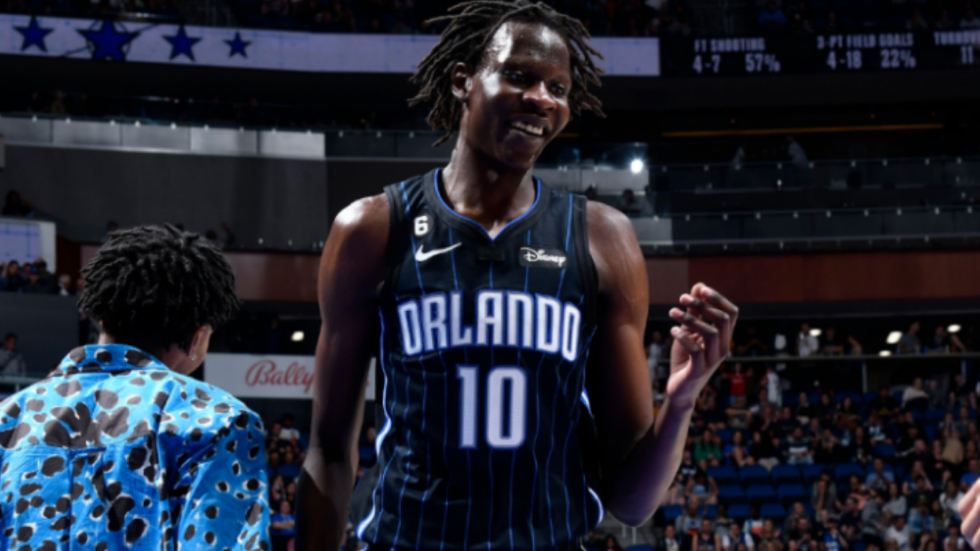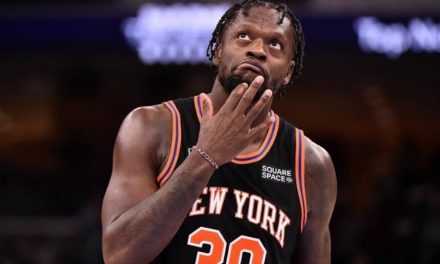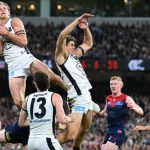Earlier this season, Bol Bol helped form one of the biggest line-ups in the NBA at the Orlando Magic. Photo: Getty Images.
When did you first hear the term ‘small ball’?
Was it when the Houston Rockets traded starting centre Clint Capela back in early 2020 to accommodate star guards James Harden and Russell Westbrook?
Was it when the Golden State Warriors – to astounding success, it must be said – rode a line-up anchored by 6’6” Draymond Green?
How about when ‘The Heatles’ started nominal small forward Shane Battier as a centre?
Perhaps it was all the way back in the early 1990s when the NBA’s original mad scientist Don Nelson played the 6’7” shooting guard Rod Higgins at the five for long stretches?
No matter when you first came upon the concept, it stood out as an anomaly.
The NBA has always been a big man’s league – from its inception in 1947 through to 1980, the only non-bigs to win the MVP award were Bob Cousy in 1957 and Oscar Robertson in 1964 who were both point guards and both undoubted all-time greats.
As a rule, NBA teams were always built around the big man: George Mikan, Bob Pettit, Wilt Chamberlain, Bill Russell, Willis Reed, Kareem Abdul-Jabbar. Your big man was your star man.
As expansion, and later the ABA merger, hit the NBA, making more roster spots available, that almost pathological need for teams to roster multiple Very Large Humans didn’t abate.
Instead, it opened the door for a raft of unskilled and/or unathletic big men to clog up NBA rosters.
Just take a look at these names: Joe Kleine, Randy Brewer, Ervin Johnson Jr, Danny Schayes (though, in fairness, his father was a superstar), Jon Koncak, Robert Swift and Frederic Weis.
All of them enjoyed long and mightily unproductive careers and were more often than not high draft picks.
Kent Benson went at pick one all the way back in 1977 and his 11 years in the league garnered the gaudy return of 9.1 points and 5.7 boards per game.
Teams that bucked that trend, like Nellie’s ‘Run TMC’ Warriors, were looked at as nothing more than fun sideshows – admired, but never taken all that seriously.
The tide slowly started to turn in 1980 with the emergence of Larry Bird and Magic Johnson, a pair of 6’9” players who did things on the court that nobody had ever seen before.
Both were the fulcrums of their magnificent offences from the wing and point, respectively, despite looking like power forwards.
Michael Jordan’s arrival to the NBA only served to further push the game away from the low block, though even his own team didn’t know what it had on its hands at the time.
Those three were all big for their positions but the truest outlier from the 1980s was Isaiah Thomas.
The diminutive Pistons point guard was a devastating combination of speed, skill and toughness, leading Detroit to a pair of championships at the end of the decade.
As Magic, Bird and Zeke all wound down, Jordan dominated the 90s, winning six rings in the seven full seasons he played that decade. The other titles? They were won by the Houston Rockets and San Antonio Spurs – teams led by big men.
The turn of the century saw the emergence of Allen Iverson, Steve Nash, Kobe Bryant, LeBron James and Dwyane Wade.
Still, though, the prerequisite for ultimate success was to find yourself a star big man.
Shaquille O’Neal won four rings in the course of the decade, Tim Duncan three and Pau Gasol won a pair, although he was the Lakers’ second banana to Kobe.
The outlier were the 2004 Pistons who were a true collaboration that was led by guards Chauncey Billups and Rip Hamilton, though still sported a pair of All-Star bigs in Rasheed and Ben Wallace.
Over the past 10-12 years the prevailing belief that you need a dominant big to win big has finally been turned on its head.
Green was at best the third most important Warrior, likewise Chris Bosh with the Heat and Kevin Love on the Cavaliers.
Duncan was an ageing icon as Tony Parker led the Spurs to yet another championship, while Marc Gasol was more of a cultural leader than on floor commander for Kawhi Leonard’s Raptors.
PLEASE HELP US CONTINUE TO THRIVE BY BECOMING AN OFFICIAL FOOTYOLOGY PATRON. JUST CLICK THIS LINK.
Yet in the past few seasons we’ve seen the re-emergence of the dominant big man.
Giannis Antetokounmpo, Joel Embiid and Nikola Jokic are amongst the very best handful of basketballers on Earth, and Anthony Davis, who was a monster in the Lakers’ bubble run, looks at long last to be regaining that form.
We’ve seen small ball become an afterthought.
But let’s examine the reasons why it came to be a thing in the first place.
Personally, I’ve always had a slight issue with the term ‘small ball’. Sure, teams were eschewing size on the floor, but it was with the defined purpose of replacing those stiffs with players that could actually do something with the ball and not get isolated defensively, as opposed to simply getting faster.
The Battier/Bosh frontline had shooting, rim protection, post defence, switchability and playmaking.
Putting Draymond on the floor with Andre Iguodala, Kevin Durant, hell, even Harrison Barnes, and an all-world backcourt saw Golden State run five playmakers who could all hit a jump shot, attack the rim and create for others.
Nellie’s Warriors did the same, though less people realised that in the moment.
The Rockets opened up the floor for two of the best one-on-one players of all time. Forget ‘small ball’, it should have been labelled ‘skill ball’.
Let’s not downplay size – it has always remained important. Just not size for the sake of size.
Rudy Gobert singlehandedly altered his opponents’ attack as a member of the Utah Jazz, whilst proving a devastating roll man.
Brook Lopez is a perimeter marksman as well as the early frontrunner for Defensive Player of the Year.
A large part of Jokic’s otherworldly passing ability comes from the advantage of seeing over the defence.
Embiid and Antetokounmpo steamroll smaller players inside and out-skill them on the perimeter.
Even Timofey freakin’ Mozgov almost bullied the Warriors frontline into submission for a heavily depleted Cavaliers in the 2015 Finals.
Over the past quarter of a century, we’ve slowly seen the NBA big man develop his skillsets.
Keith Van Horn and Raef LaFrentz were early examples of the stretch big before the term was even coined.
Now, more than just shooters, the elite NBA bigs play like guards.
Giannis spent time as a point guard in his early NBA career and Jokic is the creative fulcrum of a delightful Nuggets attack.
It makes you wonder what could have been for a whole raft of NBA players.
If Kevin Garnett had been born in 1996 rather than 1976 could he have been another Giannis, only with a better jumper?
What could Derrick Coleman have become in the modern NBA?
Karl Malone – a sneakily brilliant distributor – might have ran the point had he come into the league in 2015 rather than 1985.
On the flipside, LeBron might have averaged 35 a night as a low post hub, but wouldn’t be the player we know today, had he played in the 1970s and 80s.
It’s not just on offence where the return of the big man has impacted the NBA game.
A team’s ability to play five very large men without losing anything skills-wise is, if you’ll excuse the obvious pun, huge.
Earlier this season the Orlando Magic, with practically their entire guard rotation injured, regularly rolled out a line-up of Caleb Houstan (6’8”), Franz Wagner (6’9”), Paolo Banchero (6’10”), Wendell Carter Jr (6’10’”) and Bol Bol (7’2”).
It should go without saying, but that quintet is f–king enormous!
With Banchero and Wagner sharing point guard duties and the seven-foot Bol acting as a nominal wing, the Magic lost nothing in the skills department, whilst being literally everywhere at once on defence.
This, folks, is the modern NBA – five physical anomalies who can all shoot (or, alternatively, space the floor vertically), create and pass, and also have the ability to withstand a battering in the paint and stay in front of jitterbugs on the perimeter.
Small ball is dead; long live ‘big ball’. Somewhere, Sam Cassell is dancing.
To find more of Jarrod Prosser’s content visit vendettasportsmedia.com











